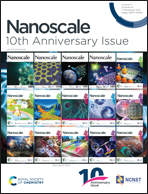Towards efficient and stable perovskite solar cells employing non-hygroscopic F4-TCNQ doped TFB as the hole-transporting material†
Abstract
Designing an efficient and stable hole transport layer (HTL) material is one of the essential ways to improve the performance of organic–inorganic perovskite solar cells (PSCs). Herein, for the first time, an efficient model of a hole transport material (HTM) is demonstrated by optimized doping of a conjugated polymer TFB (poly[(9,9-dioctylfluorenyl-2,7-diyl)-co-(4,4′-(N-(4-sec-butylphenyl)diphenylamine)]) with a non-hygroscopic p-type dopant F4-TCNQ (2,3,5,6-tetrafluoro-7,7,8,8-tetracyanoquinodimethane) for high-efficiency PSCs. The PSC with the F4-TCNQ doped TFB exhibits the best power conversion efficiency (PCE) of 17.46%, which surpasses that of the reference devices, i.e., 16.64 (LiTFSI + TBP-doped Spiro-OMeTAD as the HTM) and 11.01% (LiTFSI + TBP-doped TFB as the HTM). F4-TCNQ doped TFB was believed to favor efficient charge and energy transfer between the perovskite and the hole transport layer and to reduce charge recombination as evidenced by steady-state photoluminescence (PL) and time-resolved photoluminescence (TRPL) analysis. Moreover, the hydrophobic nature of F4-TCNQ contributed to enhancing the stability of the device under ambient conditions with a RH of 45%. The device reported herein retained ca. 80% of its initial efficiency after 10 days, significantly superior to both LiTFSI + TBP-doped Spiro-OMeTAD (ca. 30%) and LiTFSI + TBP-doped TFB (ca. 10%) based counterparts. This simple yet novel strategy paves the way for demonstrating a promising route for a wide range of highly efficient solar cells and other photovoltaic applications.

- This article is part of the themed collection: Nanoscale 10th Anniversary Special Issue


 Please wait while we load your content...
Please wait while we load your content...